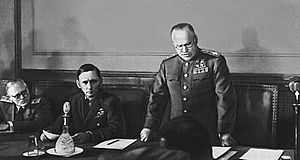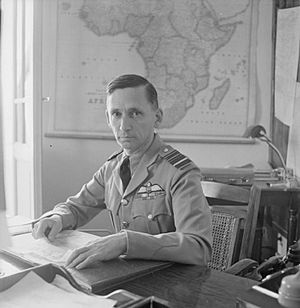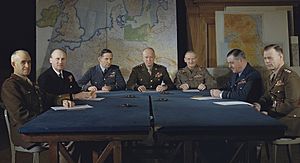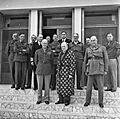Arthur Tedder, 1st Baron Tedder facts for kids
Quick facts for kids
The Lord Tedder
|
|
|---|---|

Tedder on the Italian coast in December 1943.
|
|
| Born | 11 July 1890 Glengoyne, Scotland |
| Died | 3 June 1967 (aged 76) Banstead, England |
| Allegiance | United Kingdom |
| Service/ |
British Army (1913–18) Royal Air Force (1918–50) |
| Years of service | 1913–1951 |
| Rank | Marshal of the Royal Air Force |
| Commands held | Chief of the Air Staff (1946–50) Mediterranean Allied Air Forces (1943–44) Mediterranean Air Command (1943) RAF Middle East Command (1941–43) RAF Far East (1936–38) No. 2 Flying Training School (1924–26) No. 207 Squadron (1920–23) No. 274 Squadron (1919–20) 38th Wing (1918–19) No. 67 Squadron (1917–18) No. 70 Squadron (1917) |
| Battles/wars | First World War |
| Awards | Knight Grand Cross of the Order of the Bath Mentioned in Despatches (2) Silver Medal of Military Valor (Italy) Order of Polonia Restituta (Poland) Legion of Merit (United States) Distinguished Service Medal (United States) Legion of Honour (France) Croix de guerre (France) Croix de guerre (Belgium) |
| Other work | Chancellor, University of Cambridge Vice-Chairman, BBC Board of Governors President, Standard Triumph Ltd Deputy President, National Rifle Association |
Arthur William Tedder, 1st Baron Tedder (born July 11, 1890 – died June 3, 1967) was a very important leader in the Royal Air Force (RAF). He started his career as a pilot in the First World War. He then became a senior officer in the RAF between the two World Wars. During this time, he served in places like Turkey and the Far East.
In the Second World War, Tedder was in charge of air operations in the Mediterranean and North Africa. This included the evacuation of Crete and Operation Crusader. He developed a special bombing method called the "Tedder Carpet". Later, he helped plan the invasions of Sicily and Italy. He was also the Deputy Supreme Commander for Operation Overlord, the big invasion of France.
After the war, Tedder became the Chief of the Air Staff. He worked to get more people to join the RAF. He also helped organize the Berlin Airlift in 1948. This was a huge effort to deliver supplies by air to West Berlin. Tedder also held important jobs in business and education.
Contents
Early Life and Education
Arthur Tedder was born in Scotland on July 11, 1890. His father worked for the government and helped create the old age pension scheme. Because of his father's job, Arthur lived in different parts of the British Isles as a child.
He went to Whitgift School until 1909. Then, he studied history at Magdalene College at the University of Cambridge. In 1912, he spent time in Berlin learning German. He wanted to become a diplomat. In 1913, he joined the Dorsetshire Regiment as a second lieutenant.
After university, Tedder worked in Fiji for a short time. But he didn't like it there. When war started, he returned to Britain to join the regular Army.
Military Career Highlights
First World War Service
In October 1914, Tedder became a lieutenant in the Dorset Regiment. He injured his knee, which meant he couldn't serve in the infantry. So, he asked to join the Royal Flying Corps.
In January 1916, he was accepted into the Royal Flying Corps. He learned to fly and earned his "wings." By June 1916, he was a pilot on the Western Front. He flew a Bristol Scout C. He quickly became a flight commander. In 1917, he was promoted to major. He became the officer commanding No. 70 Squadron. He received an Italian medal for his bravery. Later, he commanded No. 67 Squadron and a training school in Egypt.
Between the World Wars
After the First World War, Tedder joined the new Royal Air Force (RAF) in 1919. He commanded No. 274 Squadron, which had very large bombers. His squadron was sent to Turkey for a short time in 1922.
He continued to rise through the ranks in the RAF. He became a wing commander in 1924. He commanded RAF Digby and a flying training school. He also worked at the Air Ministry, which was in charge of the RAF. In 1929, he became Assistant Commandant at the RAF Staff College.
In 1936, Tedder was put in charge of RAF forces in the Far East. This included units from Burma to Hong Kong. He was promoted to air vice marshal in 1937. In 1938, he became the Director General for Research at the Air Ministry.
Second World War Leadership
When World War II began in 1939, Tedder's department moved to a new ministry. In November 1940, he became Deputy Air Officer Commanding in Chief for RAF Middle East Command. He was then promoted to lead the RAF Middle East Command in June 1941.
In this role, he led air operations in the Mediterranean and North Africa. This included helping with the evacuation of Crete. He also commanded air support for Operation Crusader in North Africa. Tedder helped build up the air force in the Western Desert. He created new ways of fighting that were very effective. These methods helped the Allies win the important Battle of El Alamein in October 1942. One of his bombing tactics was called the "Tedder Carpet". This involved dropping many bombs in a small area.
In February 1943, Tedder took command of Mediterranean Air Command. He worked under U.S. General Dwight D. Eisenhower. He was deeply involved in planning the invasion of Sicily and then the invasion of Italy. He received awards from America and Poland for his service. In December 1943, he became Commander of Mediterranean Allied Air Forces.
For Operation Overlord, the invasion of France, Tedder was chosen as Deputy Supreme Commander. He worked directly under General Eisenhower. He played a key role in the planning and execution of this massive operation. In May 1945, when Germany surrendered, Tedder signed the surrender document for General Eisenhower. He was promoted to Marshal of the Royal Air Force in September 1945.

After the War
After the war, Tedder became the Chief of the Air Staff in January 1946. He worked to increase the number of people joining the RAF. He also doubled the size of Fighter Command. He was key in organizing the Berlin Airlift in 1948. This was a huge operation to fly supplies into West Berlin.
He was given the title of Baron Tedder in 1946. He also received the American Distinguished Service Medal. In 1950, he became Chairman of the British Joint Services Mission in Washington, D.C. He retired in May 1951. Tedder also led a Royal Commission on university education in Dundee. This led to the creation of Queen's College, Dundee.
Later Life and Legacy
In his later years, Tedder wrote about the history of the Royal Navy. He also wrote his own war memories. In November 1950, he was elected Chancellor of the University of Cambridge. He also served as Chairman of the Standard Motor Company. He was also Vice-Chairman of the Board of Governors of the BBC.
Arthur Tedder passed away on June 3, 1967, at his home in Surrey. His ashes are buried in St Clement Danes church in London, which is known as the RAF church. His name is also on a memorial in Westminster Abbey.
Family Life
In 1915, Tedder married Rosalinde Maclardy. They had two sons and one daughter. Sadly, his first wife died in an aircraft crash in Egypt in 1943. Later that year, Tedder married Marie Black. His children included Dick (who died in France in 1940), John Michael, Richard, and Mena.
Images for kids
-
A meeting of important leaders. From left to right: John Whiteley, Air Marshal Arthur Tedder, Brigadier G. S. Thompson, Admiral Sir John Cunningham, unknown, Sir Harold Alexander, Captain M. L. Power, Humfrey Gale, Leslie Hollis, and Eisenhower's chief of staff, Walter Bedell Smith.
See also
 In Spanish: Arthur Tedder para niños
In Spanish: Arthur Tedder para niños




